Themed collection Engineering the biosynthesis of fungal natural products

Introduction to engineering the biosynthesis of fungal natural products
Guest editors Russell Cox and Tobias Gulder introduce this Natural Products Reports themed issue summarizing recent progress in engineering the biosynthesis of fungal natural products.

Nat. Prod. Rep., 2023,40, 7-8
https://doi.org/10.1039/D2NP90047E
Out for a RiPP: challenges and advances in genome mining of ribosomal peptides from fungi
This Highlight reviews previous discoveries of ribosomal peptides in fungi, groups these natural products into three distinct families based on their unique properties and outlines how to leverage these properties for genome mining.
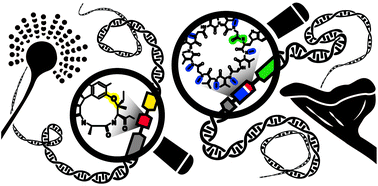
Nat. Prod. Rep., 2022,39, 222-230
https://doi.org/10.1039/D1NP00048A
Current status of secondary metabolite pathways linked to their related biosynthetic gene clusters in Aspergillus section Nigri
Aspergilli are biosynthetically ‘talented’ micro-organisms and therefore the natural products community has continually been interested in the wealth of biosynthetic gene clusters (BGCs) encoding numerous secondary metabolites related to these fungi.

Nat. Prod. Rep., 2023,40, 237-274
https://doi.org/10.1039/D1NP00074H
Biosynthesis of indole diterpenes: a reconstitution approach in a heterologous host
Reconstitution studies applying the 3-stage strategy to the synthesis of highly elaborated indole diterpenes are reviewed.
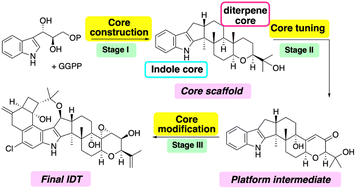
Nat. Prod. Rep., 2023,40, 202-213
https://doi.org/10.1039/D2NP00031H
The ‘emodin family’ of fungal natural products–amalgamating a century of research with recent genomics-based advances
A large and diverse family of fungal compounds are those related to the anthraquinone emodin. By viewing this family as a whole and combining our genetic and chemical understanding, we gain detailed insights into their biosynthetic origins.
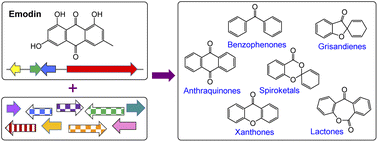
Nat. Prod. Rep., 2023,40, 174-201
https://doi.org/10.1039/D2NP00040G
The expanding CRISPR toolbox for natural product discovery and engineering in filamentous fungi
This review provides an overview of CRISPR/Cas-based strategies for biosynthetic gene cluster engineering in filamentous fungi.

Nat. Prod. Rep., 2023,40, 158-173
https://doi.org/10.1039/D2NP00055E
Maleidride biosynthesis – construction of dimeric anhydrides – more than just heads or tails
We review studies from early isolation and elucidation to recent bioinformatics and in vitro work regarding the biosynthesis of maleidrides. These are dimeric anhydrides, made from monomers coupled in various modes leading to structural diversity.

Nat. Prod. Rep., 2023,40, 128-157
https://doi.org/10.1039/D2NP00041E
Deciphering chemical logic of fungal natural product biosynthesis through heterologous expression and genome mining
Heterologous expression of biosynthetic gene clusters (BGCs) has become a widely used tool for genome mining of cryptic pathways, bottom-up investigation of biosynthetic enzymes, and engineered biosynthesis of new natural product variants.
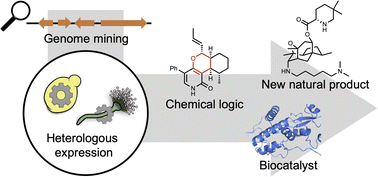
Nat. Prod. Rep., 2023,40, 89-127
https://doi.org/10.1039/D2NP00050D
Engineering the biosynthesis of fungal nonribosomal peptides
Fungal nonribosomal peptides (NRPs) and the related polyketide–nonribosomal peptide hybrid products (PK–NRPs) are a prolific source of bioactive compounds, some of which have been developed into essential drugs.
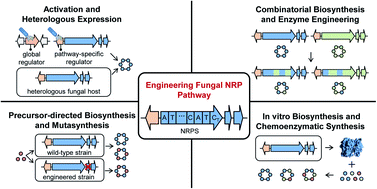
Nat. Prod. Rep., 2023,40, 62-88
https://doi.org/10.1039/D2NP00036A
Structure-based engineering of α-ketoglutarate dependent oxygenases in fungal meroterpenoid biosynthesis
The α-ketoglutarate dependent oxygenases catalyze remarkable chemistries in polyketide-derived fungal meroterpenoid biosynthesis. This review summarizes recent progress in the structure-based engineering of these enzymes.

Nat. Prod. Rep., 2023,40, 46-61
https://doi.org/10.1039/D2NP00014H
Engineering fungal terpene biosynthesis
This review summarises recent research on metobolic engineering approaches towards terpenes, including work to investigate unknown pathways and to improve accessibility of known compounds.

Nat. Prod. Rep., 2023,40, 28-45
https://doi.org/10.1039/D2NP00020B
Curiouser and curiouser: progress in understanding the programming of iterative highly-reducing polyketide synthases
Current understanding of iterative highly programmed Type 1 PKS that control starter unit selection, chain length, methylation pattern, and stereochemistry.

Nat. Prod. Rep., 2023,40, 9-27
https://doi.org/10.1039/D2NP00007E
Fungal bioactive macrolides
Macrolides, which are widely found in plants and microorganisms, are polyketides constituted of different-sized rings lactones. They show different biological activities and the review focused on their isolation from fungi in the last four decades.

Nat. Prod. Rep., 2022,39, 1591-1621
https://doi.org/10.1039/D2NP00025C
Fungal–fungal co-culture: a primer for generating chemical diversity
In their natural environment, fungi must compete for resources. It has been hypothesized that this competition likely induces the biosynthesis of secondary metabolites for defence.

Nat. Prod. Rep., 2022,39, 1557-1573
https://doi.org/10.1039/D1NP00070E
Biosynthesis of fungal polyketides by collaborating and trans-acting enzymes
Investigations into fungal polyketide biosynthesis have revealed many examples of megasynthases and trans-acting accessory enzymes. This review collates the different classes of collaborating enzymes, demonstrating common themes and rarer examples.
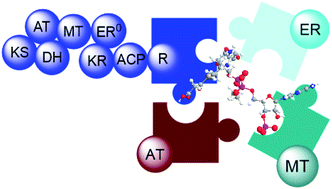
Nat. Prod. Rep., 2022,39, 754-783
https://doi.org/10.1039/D1NP00056J
Non-peptide secondary metabolites from poisonous mushrooms: overview of chemistry, bioactivity, and biosynthesis
This review provides an overview of the current information on non-peptide secondary metabolites from poisonous mushrooms, focusing on their chemistry, bioactivity, and biosynthesis, highlighting their potential for drug development.

Nat. Prod. Rep., 2022,39, 512-559
https://doi.org/10.1039/D1NP00049G
The chemical ecology of the fungus-farming termite symbiosis
Since the early 1970s, 375 natural products have been identified from members of the fungus-farming termite symbiosis, and this review summarises and discusses the ecological implications of the presence of this vast chemical repertoire.
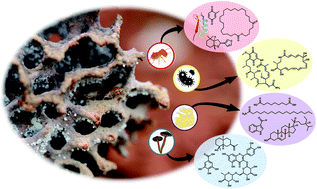
Nat. Prod. Rep., 2022,39, 231-248
https://doi.org/10.1039/D1NP00022E
About this collection
This themed issue is Guest Edited by Russell Cox and Tobias Gulder.